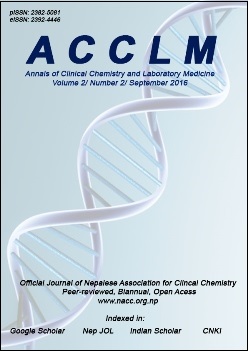Evaluation of Serum Lipids and C-peptide among Breast Cancer Patients with Chemotherapy
DOI:
https://doi.org/10.3126/acclm.v2i2.15589Keywords:
Breast cancer, chemotherapy, C-peptide, lipid profile.Abstract
Background: Chemotherapy agents alter serum lipids and C-peptide in cancer patients increased incidence of cardiovascular disorders and diabetes, although mechanisms for these are not known. Diabetes and cardiovascular riskis the highly concerned chemotherapy induced complications among cancer patients. This study is aimed to evaluate the serum lipids and C-peptide in breast cancer patients receiving chemotherapy.
Methods: This cross-sectional study includes160 individuals comprising 80 breast cancer patients and 80 controls with age ranges from 24 to 76 years. Patients received at least 3 cycles of chemotherapy. Serum Total cholesterol (TC), high density lipoprotein cholesterol (HDL) andC-peptide level was measuredin random blood sampleswhereas,other lipid parameters like Non HDL (TC-HDL),cardiac risk ratio (TC: HDL) and Non-HDL: HDL werecalculated.
Results: SerumTC, Non-HDL, TC: HDL, Non-HDL: HDL and C-peptide were significantly increased in breast cancer patients as compared to control group (p<0.001). HDL cholesterol level inpremenopausal and postmenopausalpatients was decreased but was not statistically significant different.
Conclusions: Altered serum lipid parameters and C-peptide indicated the risk of cardiovascular diseases and diabetes in cancer patients. Routine assessments of these parameters are necessary for follow up care during breast cancer management.
Clin. Chem. Lab. Med. 2016:2(2); 8-14
Downloads
Downloads
Additional Files
Published
How to Cite
Issue
Section
License
Authors who publish with this journal agree to the following terms:
- The author transfers copyright to the Nepalese Association for Clinical Chemistry.
- The journal publishes the work under a Creative Commons Attribution License that allows others to share the work with an acknowledgement of the work's authorship and initial publication in this journal and under the same share-alike license used here.
- Authors are able to enter into separate, additional contractual arrangements for the non-exclusive distribution of the journal's published version of the work (e.g., post it to an institutional repository or publish it in a book), with an acknowledgement of its initial publication in this journal.
- Authors are permitted and encouraged to post their work online (e.g., in institutional repositories or on their website) prior to and during the submission process, as it can lead to productive exchanges, as well as earlier and greater citation of published work (See The Effect of Open Access).




